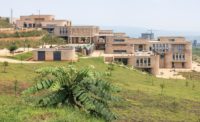“There is no system in place to subsidize architectural projects with impact in rural economies,” says Michael Murphy, a cofounder and principal of the nonprofit MASS Design Group.
The idea that thoughtful, integrated architecture is too laborious and expensive to provide to other small nonprofits motivated the Boston-based MASS to prove otherwise; it started a kind of educational and apprenticeship arm in Africa, where much of the firm’s work is located. The African Design Centre (ADC) opened in September 2016. Headquartered in Kigali, Rwanda, and led by Christian Benimana and Sarah Mohland, the center selects fellows and treats architectural projects as curriculum. The fellows approach projects as theses, researching systemic social, economic, and environmental challenges before they design and build.
Additional Content:
Jump to credits & specifications
Now the ADC has completed its inaugural project, the Ruhehe Primary School, in Rwanda, a much-needed renovation and addition to a group of existing classrooms and administration buildings. The school lacked the appropriate infrastructure to support the demands of a growing institution, which serves 1,120 students through grade six, with 20 teachers and support staff. Backed by an education-focused charitable foundation, M2, the ADC worked with the local District of Musanze to choose a school that was the most likely to benefit from investment. “If we can start from an existing school and demonstrate how to improve it and incentivize performance, that situation is more applicable to the local conditions,” says Benimana.
The ADC’s and MASS’s elegant solution for Ruhehe was to create two gently curving 16-foot-high parallel boundary walls from which four new one-story classroom and administration buildings branch toward the west. This plan separates the classrooms from a busy walking path that runs between a health center and a local government office on the north and south sides of the school, protecting students from distractions and creating a sense of an enclosed campus while preserving the school’s connection to the community. The walls dip and peak like a child’s drawing of waves—the peaks line up with the slope of the classroom roofs, and the walls, in turn, become the eastern elevations of the classrooms. A campus path cuts through breezeways in longer classroom buildings.
Consulting with experts from Nous Engineering, MASS decided to use concrete and steel for the boundary walls, cladding them with local volcanic rock. “These kinds of walls exist in the region, but not at this height, because they are typically constrained by dry-stack construction,” says Murphy. Ruhehe is in a seismic zone, so the concrete and steel were necessary, but expensive and not easily attainable; the architects tried to limit their use. Volcanic rock is a common building material in the area, and MASS and local builders are familiar with it; MASS had previously used it in their Butaro District Hospital (2011), and in their subsequent doctors’ housing in the Burera District of Rwanda’s Northern Province.
The team used this rock for the end facades of the classroom buildings but employed fired-clay bricks for roofs and other walls. Steel trusses support the classroom roofs. Inside, vibrantly decorated light shelves below the ceilings diffuse daylight that penetrates polycarbonate skylights.
Ruhehe is the third primary school that MASS has completed in Rwanda since the country expanded access to education, having eliminated school fees in 2006. The architects think they now have a model for school infrastructure that supports the district’s goals, increasing student retention and improving learning outcomes. “This entire process is replicable,” says Benimana. “The way we build allows for a phased approach and a projection for how any school can renovate.”
CreditsArchitect: MASS Design Group, 334 Boylston Street, Suite 400, Boston, MA 02116, +1 857 233 5788 and Kigali Heights, Plot 772, KG 7 Ave, Kacyiru, Kigali, +250 723 571 138, https://massdesigngroup.org
Personnel in architect's firm who should receive special credit: Sierra Bainbridge, RLA, Christian Benimana, RA, Sarah Mohland, Michael Murphy, INT FRIBA, Alberto Cumerlato, Rosie Goldrick, Harriet Kirk, Obed Sekamana, Theophile Uwayezu ADC Fellows: Jeremiah Oonyu, Lydia Kanakulya, Maame Prempeh, Mtamu Kililo, Yemi Kacoutie, Victor Iyakaremye, Tshepo Mokholo, Thandizo Kachiza, Mawa Moses, Zani Gichuki
Architect of record: MASS Design Group
Engineers MASS Design Group
Consultants Structural Peer Reviewer: Omar Garza, Nous Engineering Civil Peer reviewer: Paul Avery, Oak Consulting Group Structural Review of Existing Buildings: Kayihura Nyundo, Ubatsi Environmental Engineering: Krista Palen, Transsolar
General contractor: MASS Design Group & ADA Company Ltd
Photographer: Iwan Baan |
SpecificationsExterior Cladding Masonry: SKAT fired brick: Cooperative COOMIVA Musanze, Volcanic stone: Gahunga Quarry in Musanze
Roofing Metal: Steel Hollow section: Roofings Manufacturing Ltd. Tile/shingles: Roman Clay Tiles: Nyirangarama
Windows Wood frame: Cypress panelling: Atelier Economa General Metal frame: Steel Hollow section: Roofings Manufacturing Ltd.
Glazing Skylights: Polycarbonate sheet: Quincaillerie Mateco
Doors Metal doors: Steel Pivot Doors with Timber Paneling Upswinging doors, other: Woven Doors: Bamboo Screen
Interior Finishes Paints and stains: Eggshell color paint: crown paints Rwanda Paneling: Cypress TNG ceiling panels: Atelier Economa General Special interior finishes unique to this project: Light shelf: Mural by Kurema Kureba Kwiga
Furnishings Other furniture: Students & Teachers desks: Metal frame with wooden desktop: Atelier Economa General Musanze. |










Post a comment to this article
Report Abusive Comment